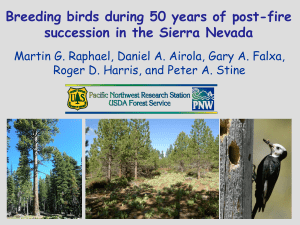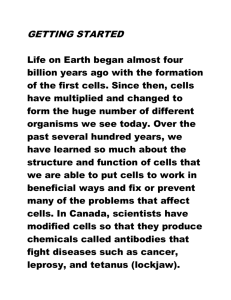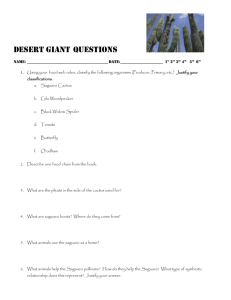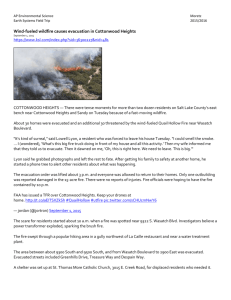Post-Fire Saguaro Community: Impacts on Associated Marcia Narog Ruth Wilson
advertisement
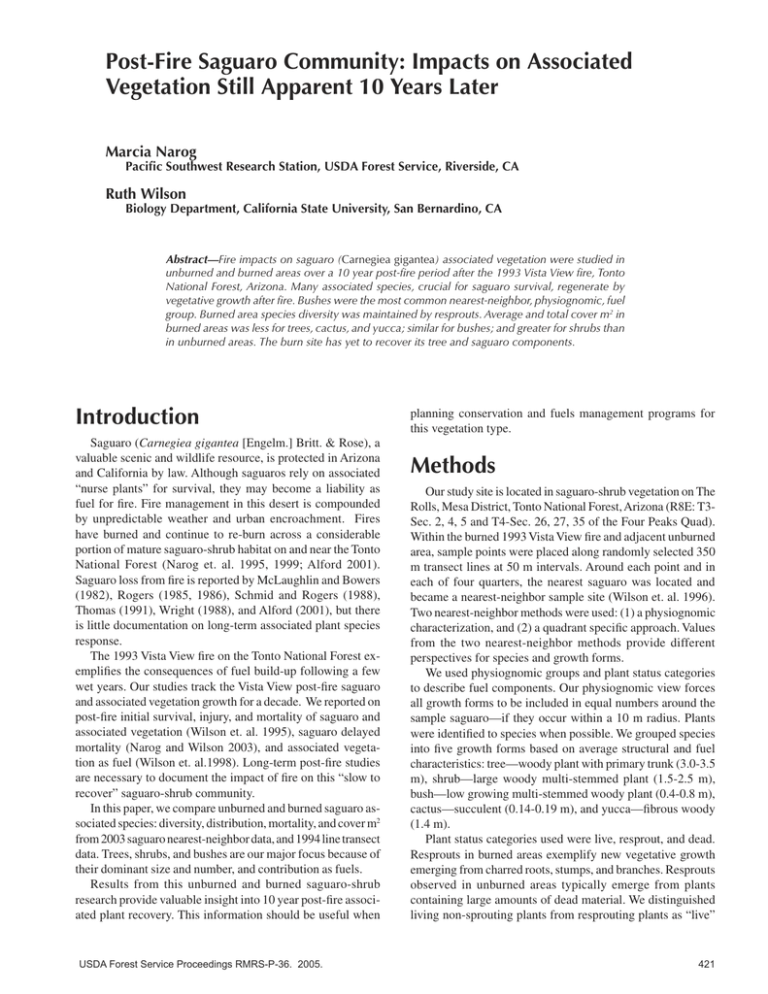
Post-Fire Saguaro Community: Impacts on Associated Vegetation Still Apparent 10 Years Later Marcia Narog Pacific Southwest Research Station, USDA Forest Service, Riverside, CA Ruth Wilson Biology Department, California State University, San Bernardino, CA Abstract—Fire impacts on saguaro (Carnegiea gigantea) associated vegetation were studied in unburned and burned areas over a 10 year post-fire period after the 1993 Vista View fire, Tonto National Forest, Arizona. Many associated species, crucial for saguaro survival, regenerate by vegetative growth after fire. Bushes were the most common nearest-neighbor, physiognomic, fuel group. Burned area species diversity was maintained by resprouts. Average and total cover m2 in burned areas was less for trees, cactus, and yucca; similar for bushes; and greater for shrubs than in unburned areas. The burn site has yet to recover its tree and saguaro components. Introduction Saguaro (Carnegiea gigantea [Engelm.] Britt. & Rose), a valuable scenic and wildlife resource, is protected in Arizona and California by law. Although saguaros rely on associated “nurse plants” for survival, they may become a liability as fuel for fire. Fire management in this desert is compounded by unpredictable weather and urban encroachment. Fires have burned and continue to re-burn across a considerable portion of mature saguaro-shrub habitat on and near the Tonto National Forest (Narog et. al. 1995, 1999; Alford 2001). Saguaro loss from fire is reported by McLaughlin and Bowers (1982), Rogers (1985, 1986), Schmid and Rogers (1988), Thomas (1991), Wright (1988), and Alford (2001), but there is little documentation on long-term associated plant species response. The 1993 Vista View fire on the Tonto National Forest exemplifies the consequences of fuel build-up following a few wet years. Our studies track the Vista View post-fire saguaro and associated vegetation growth for a decade. We reported on post-fire initial survival, injury, and mortality of saguaro and associated vegetation (Wilson et. al. 1995), saguaro delayed mortality (Narog and Wilson 2003), and associated vegetation as fuel (Wilson et. al.1998). Long-term post-fire studies are necessary to document the impact of fire on this “slow to recover” saguaro-shrub community. In this paper, we compare unburned and burned saguaro associated species: diversity, distribution, mortality, and cover m2 from 2003 saguaro nearest-neighbor data, and 1994 line transect data. Trees, shrubs, and bushes are our major focus because of their dominant size and number, and contribution as fuels. Results from this unburned and burned saguaro-shrub research provide valuable insight into 10 year post-fire associated plant recovery. This information should be useful when USDA Forest Service Proceedings RMRS-P-36. 2005. planning conservation and fuels management programs for this vegetation type. Methods Our study site is located in saguaro-shrub vegetation on The Rolls, Mesa District, Tonto National Forest, Arizona (R8E: T3Sec. 2, 4, 5 and T4-Sec. 26, 27, 35 of the Four Peaks Quad). Within the burned 1993 Vista View fire and adjacent unburned area, sample points were placed along randomly selected 350 m transect lines at 50 m intervals. Around each point and in each of four quarters, the nearest saguaro was located and became a nearest-neighbor sample site (Wilson et. al. 1996). Two nearest-neighbor methods were used: (1) a physiognomic characterization, and (2) a quadrant specific approach. Values from the two nearest-neighbor methods provide different perspectives for species and growth forms. We used physiognomic groups and plant status categories to describe fuel components. Our physiognomic view forces all growth forms to be included in equal numbers around the sample saguaro—if they occur within a 10 m radius. Plants were identified to species when possible. We grouped species into five growth forms based on average structural and fuel characteristics: tree—woody plant with primary trunk (3.0-3.5 m), shrub—large woody multi-stemmed plant (1.5-2.5 m), bush—low growing multi-stemmed woody plant (0.4-0.8 m), cactus—succulent (0.14-0.19 m), and yucca—fibrous woody (1.4 m). Plant status categories used were live, resprout, and dead. Resprouts in burned areas exemplify new vegetative growth emerging from charred roots, stumps, and branches. Resprouts observed in unburned areas typically emerge from plants containing large amounts of dead material. We distinguished living non-sprouting plants from resprouting plants as “live” 421 and “resprout live,” respectively. Measurable dead material within a plant was recorded as “dead in plant.” Distance from the saguaro and plant dimensions (height, and two diameters) were measured for each nearest-neighbor. In addition, 1994 data from five 100 m line transects in burned and adjacent unburned areas were used to calculate 1-year post-fire cover m2. The quadrant specific method was used around each sample saguaro to count species within a 5 m radius (78.5 m2) circular plot and identify the one nearest-neighbor per quadrant—regardless of growth form. Total quadrant density and cover m2 per species were used to calculate average cover m2 for the circular plots. Total cover m2 was standardized to adjust for the higher number of saguaro sample sites on the burned plot. Values were converted to relative percent to compare burned and unburned samples of different sizes. Details for other computations are listed in footnotes on table 1. Discussion of Results Ten year post-fire physiognomic data from unburned and burned sample areas are represented by number and relative percent occurrence for each species under each growth form (table 1). We observed differences in species occurrence between burned and unburned areas. Plants with the highest relative percent occurrence were: trees—paloverde in unburned and crucifixion thorn in burned areas; shrubs—wolfberry in unburned and whitethorn in burned areas; and bushes—golden bush and bursage in unburned, and globe mallow and white Table 1—Ten-year post-fire saguaro nearest-neighbor plant species and numbers for each physiognomic groupa and speciesb in unburned (U) and burned (B) 2003 point quarter physiognomic and quadrant specific samples on the 1993 Vista View Fire, Tonto National Forest, AZ. Physiognomic methodc Growth form Scientific name Tree—small woody trunks Canotia holacantha Cercidium microphyllum Unknown charred Common name Number of samples of occurrence U B Quadrant specific methodd Relativee percent occurrence U B Relativef percent number U B Abundanceg index number U B 24 3 21 -- 25 15 9 1 100 13 88 -- 86 52 31 3 3 -3 -- 3 3 --- 1.4 3.0 1.2 -- 1.2 1.6 1.2 -- Shrub—large woody multiple stems Acacia constricta White thorn Acacia greggii Catclaw Larrea tridentata Creosote bush Lycium spp. Wolfberry 23 8 2 1 12 29 18 --11 96 33 8 4 50 100 62 --38 9 1 --8 12 4 2 -6 2.2 2.0 2.3 2.0 2.2 1.7 1.9 1.6 -1.2 Bush—woody bases and low branches Ambrosia deltoidea Bursage Calliandra eriophylla Fairy duster Encelia spp. Brittle bush Ephedra spp. Mormon tea Ericameria spp. Golden bush Krameria grayi White ratany Sphaeralcea ambigua Globe mallow Thamnosma montana Turpentine broom 24 4 1 0 4 9 1 -2 28 3 1 1 4 1 4 7 3 100 17 4 0 17 38 4 -8 97 10 3 3 14 3 14 24 10 77 19 4 1 6 24 4 1 7 77 10 10 2 6 7 8 19 3 7.1 31.8 5.3 1.4 2.4 9.5 2.6 1.3 2.2 5.7 9.3 9.6 8.2 2.0 3.5 3.7 10.4 1.5 Cacti—succulents Echinocereus engelmannii Opuntia engelmannii Opuntia leptocaulis Opuntia versicolor 22 2 1 4 15 25 2 2 1 20 92 8 4 17 63 86 7 7 3 69 4 --1 3 3 ---3 3.2 2.7 1.5 2.5 4.2 1.7 1.7 1.0 1.0 2.1 Carnegiea gigantean—giant woody succulent 2 3 8 10 -- 2 -- -- Yucca torreyi—woody and fibrous 4 15 17 52 3 3 2.3 2.4 Crucifixion thorn Foothill paloverde Hedgehog Prickly pear Desert Christmas Staghorn cholla a Physiognomic group (growth form) is designated by physical structure as tree, shrub, bush, cactus, and yucca. Species with low occurrence or relative percent number were removed from the table but used in calculations they include; Asteraceae, Eriogonum spp., Gutierrezia sp., Lonicera sp., Mirabilis sp., Palafoxia sp., Psilotrophe sp., Senna sp., and dead. c Burned (N = 29), unburned (N = 24) saguaro sample sites with 1 each nearest-neighbor physiognomic type, within a 10 m radius. d Bur e Relative % occurrence; for growth form = total number of sample sites for growth form x / total number of sample sites X 100 = %; and for species = total number of sample sites for species x / total number sample sites for species growth form X 100 = %. f Relative % number = total number of species x or growth form x / total number of all species X 100 = %. g Abundance index (number species x / frequency species x) = total number of species x / number of saguaro sample sites for species x = average number for saguaro sample sites in which species x occurs (total live N = 906, burned and 1,251 unburned. b 422 USDA Forest Service Proceedings RMRS-P-36. 2005. ratany in burned areas. Mormon tea was common in both areas. Among the cacti, staghorn cholla occurrence was highest in both unburned and burned areas. Yucca occurrence was lower in unburned than in burned areas. Quadrant specific data presented as relative percent are close if not identical for growth forms in unburned and burned samples (table 1). Among growth forms, bushes were highest and trees, yucca, and cacti were lowest. Most species were evenly distributed among sample areas. Plants with a generally widespread yet clustered pattern around the saguaro scored high in relative percent and abundance index, e.g., bursage in unburned areas, and globe mallow in burned (table 1). Plant status data from the physiognomic method was evaluated at 10 m, 5 m, 1.5 m and 1 m radii for average cover m2 (table 2). Tree species numbers drop off sharply as the sample radii are reduced, shrubs follow, and bush number remains relatively constant within 1 m. New branch regeneration may obscure burned skeletons and makes it difficult to distinguish resprout status. Resprouting bushes reported for 2003 are low considering the high number observed in 1994 (table 3). Among burned area trees, 56 percent were dead persistent skeletons, and 54 percent of the living trees were resprouting, some with dead branches mixed within the live—dead in plant (table 2). Among burned shrubs 62 percent are still identifiable as resprouts. Unburned area live relative percent total cover m2 calculated from table 2 exceeds burned (figure 1). In burned areas, resprouts have twice the cover m2 as live, largely attributable to shrubs. Dead cover m2 in unburned areas is twice that of burned because of five large dead paloverde. Table 2—Ten-year post-fire saguaro nearest-neighbor plant statusa, number and average for tree shrub and bush from 2003 point quarter 10 m, 5 m, 1.5 m, and 1 m radii physiognomic samples on the 1993 Vista View fire from burned and unburned plots, Tonto National Forest, AZ. Plant status Number and average Cover (m2) Distance (m) Number Cover (m2) Distance (m) 24 15 1 0 19 11 1 10.0 m 5.0 m 1.5 m 1.0 m 23 23 9 7 23 22 9 7 2.13 1.98 0.79 0.64 3.89 3.81 3.26 3.02 10.0 m 5.0 m 1.5 m 1.0 m 24 24 23 22 21 21 20 19 0.55 0.55 0.50 0.45 0.70 0.70 0.63 0.62 1 1 1 1 10.0 m 5.0 m 1.5 m 1.0 m 25 19 12 3 5 2 7.20 10.32 4.65 20.78 -No live plants 6 6 1 10.0 m 5.0 m 1.5 m 1.0 m 29 27 11 6 11 10 3 1 2.91 2.34 1.22 0.95 2.44 2.09 3.57 3.80 18 17 8 5 2.24 2.04 0.79 0.53 6.71 6.89 7.90 7.78 No dead No dead No dead No dead 4 4 2 1 2.43 2.43 0.95 0.50 2.82 2.82 3.33 3.96 10.0 m 5.0 m 1.5 m 1.0 m 28 28 28 27 26 26 26 25 0.60 0.60 0.59 0.57 0.88 0.88 0.88 0.85 2 2 2 2 0.40 0.40 0.90 0.40 0.00 0.00 0.00 0.00 No dead No dead No dead No dead 2 2 2 2 0.40 0.40 0.40 0.40 0.02 0.02 0.16 0.16 Radius Number Cover (m2) Distance (m) Dead in plantb 10.0 m 5.0 m 1.5 m 1.0 m Growth form Number Dead Number Cover (m2) Resprout Total N Treatment Distance (m) Live Unburned Tree Shrub Bush Burned Tree Shrub Bush a b 4.74 28.40 2.85 37.17 1.30 15.68 No live No resprouts No resprouts No resprouts No resprouts 5 4 No resprouts No resprouts No resprouts No resprouts 0.30 0.30 0.30 0.30 4.82 41.27 3.58 33.33 No dead No dead 3 8.60 5.97 No dead in plant No dead in plant No dead in plant No dead No dead No dead No dead 1 1.60 2.20 1 1.60 2.20 No dead in plant No dead in plant 0.02 0.02 0.02 0.02 2 2 2 2 0.30 0.30 0.30 0.30 0.02 0.02 0.02 0.02 No dead in plant No dead in plant No dead in plant No dead in plant 2.98 7.57 2.98 7.57 1.50 8.28 No resprouts 14 11 11 3 3.00 1.93 0.92 0.53 8.87 9.80 7.92 7.25 3 4.70 3.75 2 2.10 4.09 No dead in plant No dead in plant Plant status classification = live, resprout, dead, and dead in plant. Dead in plant is dead plant parts in an otherwise live plant. USDA Forest Service Proceedings RMRS-P-36. 2005. 423 Treatment Growth form Unburneda Tree Shrub Bush Burnedb Tree Shrub Bush 29 46 174 Live Live Live 10.82 3.27 0.55 15 29 45 Resprout Resprout Resprout 4.86 3.34 0.44 150 Unburned Burned 120 90 60 30 0 Tree Bush Cactus Yucca Figure 2—Quadrant specific data (saguaro nearest-neighbor per quadrant within a 5 m radius) relative percent average cover m2 for unburned (100%) and burned (comparative %) areas, from 2003 samples (N = 211) on the 1993 Vista View fire, Tonto National Forest, AZ. 40 Unburned Burned 20 0 Live Resprout live Dead Dead in plant Plant status Figure 1—Physiognomic data for unburned and burned samples as relative percent total cover m2 (tree, shrub, and bush; N = 1,117 m2), for plant status from 2003 saguaro nearest-neighbor 10 m radius samples (N = 153) on the 1993 Vista View fire, Tonto National Forest, AZ. Both quadrant specific (figure 2) and physiognomic (figure 3) data reveal similar trends, in tree, shrub, and bush size relationships. Average relative percent cover m2 is smaller in burned than unburned areas for trees, cactus, and yucca (figure 2). Burned area shrub average cover m2 exceeded unburned by 65 percent. Bush average cover m2 varied little. Total relative percent cover m2, regardless of status, illustrates that plant cover remains depressed in burned compared to unburned areas—especially for trees (figure 3). In 1994, both total number and average cover m2 of burned area resprouting trees, shrubs, and bushes were about onethird that of unburned live plants (table 3). Between 1994 and 2003, both burned area tree resprouts and unburned live shrubs increased in average cover m2 (table 2 cf. table 3). By 2003, burned shrub resprouts had doubled their average cover m2 and were 2.7 times larger than their “non-resprouting” 424 Shrub Physiognomic groups Unburned; dead—1 bush. Burned; dead—7 bushes, 6 trees, and live—2 bushes, 1 tree. Relative percent total cover m2 b Number Average cover m2 180 Relative percent total cover m2 a Plant statusa Relative percent average cover m2 Table 3—Number, plant status, and average cover m2 for tree, shrub and bush, saguaro associated vegetation from five 100 m line transects for both 1994 unburned and burned sample plots on the 1993 Vista View fire, Tonto National Forest, AZ. 80 Unburned Burned 60 40 20 0 Tree Shrub Bush Physiognomic groups Figure 3—Physiognomic data for unburned and burned samples as relative percent total cover m2 (N = 1,174 m2) for tree, shrub, and bush from 2003 saguaro nearest-neighbor 10 m radius samples (N = 153) on the 1993 Vista View fire, Tonto National Forest, AZ. associates. Bush average cover m2 increased for both unburned and burned areas. Live tree size was too variable to contrast between sample dates. Fuel distribution around a saguaro is represented for unburned (figure 4) and burned (figure 5) areas. Total living cover m2 in the unburned area is still about 20 percent greater than in the burned. About half of the burned area living plants are resprouts. Trees comprised most of the dead vegetation found in both burned and unburned areas. Compared to the unburned, the burn area has 12 percent more open area where the potential for fine herbaceous fuel accumulation persists while its tree, shrub, and bush components regenerate. USDA Forest Service Proceedings RMRS-P-36. 2005. Finer fuels Bare ground 17% Dead 8% Dead 2% Live 34% Finer fuels Bare ground 29% Resprout 0% Live 81% Unburned Burned Resprout 29% Figure 4—Relative percent cover m2 for an average 78.5 m2 circular plot around an average saguaro from an unburned 2003 sample site adjacent to the 1993 Vista View fire, Tonto National Forest, AZ. Quadrant density and cover m2 from physiognomic and quadrant specific tree, shrub, and bush data were combined. Figure 5—Relative percent cover m2 for an average 78.5 m2 circular plot around an average saguaro from a burned 2003 sample site on the 1993 Vista View fire, Tonto National Forest, AZ. Quadrant density and cover m2 from physiognomic and quadrant specific tree shrub and bush data were combined. Summary and solutions in urban interface and wildland ecosystems; 1994 February 15-17; Walnut Creek, CA. Gen. Tech. Rep. PSW-GTR158. Albany, CA: U.S. Department of Agriculture, Forest Service, Pacific southwest Research Station: 175-176. Narog, M.; Wilson, R. 2003. Delayed mortality: saguaro cacti are still dying 10 years after wildfire! In: Extended abstract. Second international wildland fire ecology and fire management congress and fifth symposium on fire and forest meteorology; 2003 16-20 November; Orlando, FL. Conference CD-ROM. Available from American Meteorological Society, 45 Beacon Street, Boston, MA 02108-3693. Narog, M.; Wilson, R.; Corcoran, B. 1999. Saguaro-shrub response differs between fires. In: Reynolds R.; Reynolds, J., eds. Proceedings of the desert research symposium; fossil footprints, 1999. Redlands, CA: San Bernardino County Museum SBCMA Quarterly 46(2): 62-63. Rogers, G. F. 1985. Mortality of burned Cereus giganteus. Ecology 66(2): 630-612. Rogers, G. F. 1986. Comparison of fire occurrence in desert and non-desert vegetation in Tonto National Forest, Arizona. Madrono 33(4): 78-283. Schmid, M.; Rogers, G. F. 1988. Trends in fire occurrence in the Arizona upland subdivision of the Sonoran Desert, 1955 to 1983. The Southwestern Naturalist 33(4): 437-444. Thomas, P. 1991. Response of succulents to fire: a review. International Journal of Wildland Fire 1: 11-22. Wilson R; Narog, M.; Corcoran, B. 1998. Unburned fuels in an Arizona upland saguaro-shrub community. In: Reynolds, R.; Reynolds, J. eds. Proceedings of the desert research symposium: finding faults in the Mojave. Redlands, CA: San Bernardino County Museum SBCMA Quarterly 45(1, 2): 109. Wilson, R.; Narog, M.; Koonce, A.; Corcoran, B. 1995. Postfire regeneration in Arizona’s giant saguaro shrub community. In: Proceedings of conference on biodiversity and management of the Madrean Archipelago: the sky islands of Southwestern United States and Northwestern Mexico; 1994 September 19-23; Tucson, AZ. Gen. Tech. Rep. RM-GTR-264. Fort Collins, CO: U.S. Department of Agriculture, Forest Service, Rocky Mountain Forest and Range Experiment Station: 424-431. Wright, H. 1988. Role of fire in the management of Southwestern ecosystems. In: Proceedings of the symposium on the effects of fire in management of Southwestern natural resources, Tucson, AZ. Gen. Tech. Rep. RM-191. Fort Collins, CO: U.S. Department of Agriculture, Forest Service, Rocky Mountain Forest and Range Experiment Station: 1-5. Ten years after the 1993 Vista View fire, a once scenic vista, still displays burned and decaying giant saguaro. In this burned area, saguaro nearest-neighbor plants are recovering but still have less cover m2 and twice the number of dead trees compared to the adjacent unburned area. In the burned area, trees have less than one-third the average cover m2 of unburned trees and over half of them are dead. Diversity was maintained in this burned area mainly because the trees, shrubs, and bushes resprouted after fire. No indication of major species shifts between burned and unburned areas were found, only slight variations in abundance. Bush species tended to be more clustered as nearest-neighbors than shrubs or trees. Fuels from dead and dying trees, and overlapping shrubs and bushes place the saguaro at great risk in both unburned and previously burned areas. Different approaches to fire management may be required in this complex vegetation type based on fuel accumulation that varies with time since fire. We suggest that active fire research, prevention, and suppression programs in the saguaro-shrub continue. Acknowledgments We appreciate the assistance of the Mesa District staff, TNF, and the hard work of the field crew including: Bonni Corcoran, Christina Escobar, Warren Hanna, Patrick Mingus, Valerie Oriol, Mike Ronan, and Christie Sclafani. References Alford, E. J. 2001. The effects of fire on Sonoran Desert plant communities. Tucson, AZ: Arizona State University. 109 p. Dissertation. McLaughlin, S.; Bowers, J. 1982. Effects of wildfire on a Sonoran Desert plant community. Ecology 63(1): 246-248. Narog, M.; Koonce, A; Wilson, R.; Corcoran, B. 1995. Burning in Arizona’s giant cactus community. In: Weise, D. R.; Martin, R .E., eds., Proceedings of the Biswell symposium: fire issues USDA Forest Service Proceedings RMRS-P-36. 2005. 425
